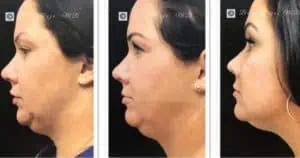
Medical Review By: Bebe Pajo, MD
Jowls are a tip-off to middle age for celebrities and the rest of us, too. Even if your skin is as smooth as a baby’s bottom, jowls can make you look older. Not so long ago, plastic surgery was the only option for getting rid of jowls, but today there are noninvasive alternatives that can restore a smoother jawline.
What are jowls? They are the loose skin that droops below the jawline. They stem from the loss of collagen that comes with age and the sagging that results. Jowls are also caused by the shrinking of bone that happens over time. That includes the cheekbones, which diminish in volume.
“When that happens, there’s less bone to hold up the fat pads in your face and your skin, and the tendency is for the cheeks to go forward and downward,” said advanced aesthetic medicine expert Bebe Pajo, MD, of Water’s Edge Dermatology. The same drooping can deepen laugh lines, the creases that extend from the edge of the nose to the outer corners of the mouth.
Genes also play a role in the development of jowls. Some people’s faces are simply destined to be jowly.
Dr. Pajo has consulted with patients ranging in age from their early 20s to 90s who want to get rid of jowls. “I educate them about what causes jowls and explain that my goal is to correct the reason you have them instead of just masking the symptoms.” She uses several non-invasive treatments to streamline the jawline, sometimes in combination, including the ones below.
Profound lift
“This treatment tightens the skin. It’s like a facelift, only it’s nonsurgical,” said Dr. Pajo.
In a Profound lift, the provider numbs the skin with an anesthetic, then inserts microneedles that deliver heat in the form of radiofrequency energy to deep layers of tissue. This heat breaks down the collagen, which stimulates the body to produce more collagen as well as elastin and hyaluronic acid, which are also essential for healthy skin.
After the procedure, which is performed in a single session lasting about 45 minutes, patients feel a little discomfort. The treatment does cause significant bruising that can last a week or more, though Dr. Pajo can offer a form of laser therapy called VBeam immediately following the treatment that helps clear swelling and discoloration in a day or two.
The full results of Profound treatment are seen after about six months. “At that time, a patient’s face looks more chiseled and narrower,” said Dr. Pajo. “We get amazing results.”
Radiesse and other hyaluronic acid fillers
Dr. Pajo uses several injectable treatments that help restore the jawline and improve the skin’s overall appearance. One is the hyaluronic acid filler Radiesse. It has a toothpaste-like texture, so it can mimic bone and restore the lost structure that supports fat pads in the face. Radiesse also stimulates collagen production, which tightens the skin. “You’re getting two benefits with this treatment,” said Dr. Pajo.
“Hyaluronic acid fillers are my choice to volumize the face, especially in younger patients who don’t have significant bone loss and wrinkles,” she noted.
The injections cause mild bruising and tenderness. Cosmetic benefits last up to a year or more.
Sculptra
Another collagen stimulator, Sculptra, can also benefit patients with jowls, said Dr. Pajo. Sculptra is made of the same material used in dissolvable stitches, so it is naturally absorbed by the body over time. It is approved by the Food and Drug Administration for smoothing facial wrinkles, including laugh lines.
The most common side effects that have been reported with Sculptra include bruising, pain at the injection site, swelling, and redness, which can last anywhere from a few days to a few weeks. Benefits can last up to several years.
Fractional CO2 laser therapy
For some patients, Dr. Pajo recommends fractional CO2 laser therapy. This treatment creates columns of microscopic perforations in the skin, which stimulate collagen growth. Within five to 10 days, the treated skin exfoliates and heals.
“It’s a great way to tighten the skin and lift jowls,” said Dr. Pajo. However, the treatment isn’t for everyone. It can cause burning and blistering in people with darker or tanned skin, Dr. Pajo noted. Patients typically experience a few days of discomfort following the procedure.
Thread lift
Dr. Pajo typically refers patients with very heavy jowls for consultation with a plastic surgeon, who may recommend a facelift or neck lift. But for patients who don’t want surgery, she often suggests a thread lift.
Unlike in a facelift, no skin is removed. Instead, the provider lifts sagging skin by pulling it back slightly, then inserting sutures, or threads, under the skin with a small needle to “anchor” loose skin in place. The sutures are eventually absorbed by the body.
“A thread lift not only lifts the jowls but stimulates collagen, too,” said Dr. Pajo.
A thread lift requires only local anesthetic, and the aftereffects are mild. You can drive yourself home and be back at work the next day, according to Dr. Pajo. She typically has the patient check-in with her after a month or so, once the swelling has subsided. If the jowls aren’t fully resolved, she often recommends adding Radiesse treatment to enhance the results.
Jowls don’t have to give away your age. Consult with a board-certified dermatologist or an aesthetic medicine physician with advanced training to discuss the options for treating them.
Article Written By: Timothy Gower, an award-winning journalist who writes about medicine and health. His work has appeared in more than two dozen national magazines.





